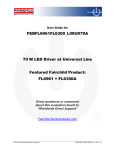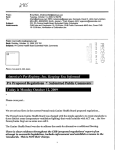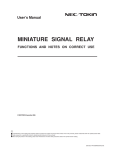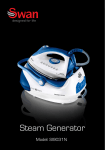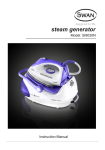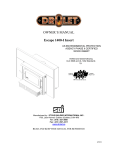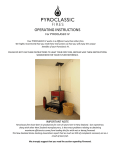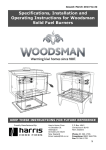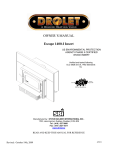Download Crighton Engineering Magnum P300 Specifications
Transcript
MAGNUM P300 JAYLINE CS600 Installation & Operation Manual 100 Neilson Street, Onehunga, Auckland, New Zealand Tel: 09 634 1483 Fax: 09 634 6804 PRE-ASSEMBLY Having removed the outer packaging from your stove, familiarise yourself with the various components and discard packing material. 1. Pedestal (Bolted to Pallet) 2. Top Grill (In position) 3. Top Baffle (Fitted inside firebox) 4. Rear Cast Iron Baffle (Packaged inside firebox) 5. Plastic Bag packaged containing: Installation and Operation Manual Specification Sheet Please Note: The Rear Baffle will require fitting into position. Ensure the patterned surface is facing forward and the words “Top Front” are at the top of the baffle. INSTALLATION Please follow carefully, all dimensions and recommendations provided on the individual specification sheet for your model of heater. These dimensions comply with the required standards of New Zealand (AS/NZS 2918:2001) A permit is required for any installation of a solid fuel space heater (wood burner) and is obtained through your local council. ********************** Inspect the outside of the building to ascertain the point of roof penetration for the flue system. If a flue system is built and installed to the correct height it will normally prevent down draught problems during windy weather and eliminate smoke spillage problems due to lack of draught. Check suitable position for appliance and size of floor protector. Ensure position of the flue pipe and, if possible, enter the ceiling space to check that no major structural members will be affected by the flue pipe path. Check that the sub-structure is capable of carrying the heater (i.e. weight consideration on the floor). Check measurements of the heater to combustibles or shield. Locate the heater in the required position. Using a plumb line, mark the flue penetration hole in the ceiling using a thin nail, driven through the ceiling. Cut the square ceiling hole to the required size and frame out. Install the flue system (see flue installation instructions supplied with flue system). Remember: · The flue system should rise vertically from the appliance with as few offsets as possible. Offsets should be avoided where possible as each change in direction creates a resistance to airflow. · The flue system must be well sealed with a minimum of 3 fixings at each joint. · The flue pipe penetrating the chimney must continue to the minimum length of 4.6m from the top of the floor protector to the cowl. · Flue exiting more than 3 metres from the ridgeline must not terminate less than 1 metre above the roof penetration (see diagram 1 below). · Where the top of the flue pipe is more than 2 metres above its highest fixing point, it must be stayed against high winds. See Diagram on following page: Drill and fix flue system into flue spigot with one stainless steel self-tapping screw. Drill and secure the appliance to the floor protector using the two rear holes behind the pedestal. HEARTH (OR FLOOR PROTECTOR) In conjunction with the Emissions & Efficiency test report applicable to the Magnum P300/Jayline CS600 (AS/NZS 4012/2 Rep. No. 07/1650), this wood burner model requires a non insulated floor protector (or Hearth). Please note: If the Magnum P300/Jayline CS600 is being installed into a property over 5 acres in size, whereby a “wetback or water booster” is permissible and being fitted, an insulated floor protector is then required. With any water heating device installed into a wood burner, the wood burner must be operated at a higher temperature, in order for the flames to be able to heat efficiently both the water and the room (or area) where the fire has been installed. In this instance the fire is performing a dual function and without being operated at a sufficiently higher temperature, “smoking” and “fly ash” can emit from the fire into the room and creosote can form easily inside the fire box, thus causing damage internally. With properties less than 5 acres in size, this model complies with the New Zealand clean air regulations and was tested without a water heating device, therefore those properties are not permitted to install a “wetback or water booster” into the Magnum P300/Jayline CS600 wood burner. The floor protector must be mechanically fixed to the floor by bolting or screwing. Please note: The floor protector must be fixed by a non flammable adhesive to a concrete floor where the floor may have water pipes or electrical wires positioned underneath. The wood burning appliance can then be bolted to the floor protector with two 8mm x 50mm dynabolts. WARNING 1. WARNING: ANY MODIFICATION OF THE APPLIANCE THAT HAS NOT BEEN APPROVED IN WRITING BY THE TESTING AUTHORITY IS CONSIDERED AS BREACHING AS/NZS 4013. 2. WARNING: DO NOT USE FLAMMABLE LIQUIDS OR AEROSOLS TO START OR REKINDLE THE FIRE. 3. WARNING: DO NOT USE FLAMMABLE LIQUIDS OR AEROSOLS IN THE VICINITY OF THIS APPLIANCE WHEN IT IS OPERATING. 4. WARNING: DO NOT STORE FUEL WITHIN HEATER INSTALLATION CLEARANCES. 5. WARNING: OPEN AIR CONTROL (AND DAMPER WHEN FITTED) BEFORE OPENING FIRING DOOR. 6. CAUTION: THIS APPLIANCE SHOULD NOT BE OPERATED WITH A CRACKED GLASS. 7. CAUTION: THIS APPLIANCE SHOULD BE MAINTAINED AND OPERATED AT ALL TIMES IN ACCORDANCE WITH THESE INSTRUCTIONS. 8. CAUTION: THE USE OF SOME TYPES OF CHEMICALLY TREATED WOOD AS A FUEL CAN BE HAZARDOUS. 9. USE ONLY DRY WOOD WHEN OPERATING THE FIRE. Any variation from these installation instructions or any doubts about them must be checked against the requirements of the AS/NZS 2918:2001. OPERATION OF THE MAGNUM P300 JAYLINE CS600 Simply by burning your Magnum/Jayline heater correctly, you can improve efficiency, reduce fuel consumption and minimise air pollution. Please Note: PLEASE LOAD YOUR “Magnum P300/ Jayline CS600” CLEAN AIR FIRE, FROM FRONT TO REAR ONLY. Do not burn wet timber or chemically treated timber, as this causes flue blockage, has low heat output and blackens the door glass with creosote. Burn dry seasoned timber and remember: The dryer the wood, the hotter it burns; The harder the wood, the longer it burns. STARTING A NEW FIRE: When lighting the heater for the first time dust heater, glass, trim and flue before firing to avoid particles sticking or discolouring. Once fired, some smoke and vapour will be released as the VHT painted surfaces enter the final curing process. Open all windows and doors while running the fire on high for up to 3 hours. People with respiratory, heart or other relevant medical conditions should avoid inhaling vapours during the curing process. All VHT paint will cure at the highest temperature achieved and will produce smoke again if this temperature is exceeded. To start and maintain a good fire you will need the following ingredients: 1. 2. 3. 4. A small quantity of newspaper (do not use coloured or coated paper); A packet of firelighters (optional); A quantity of finely split, dry soft wood kindling in a variety of sizes; and Seasoned firewood split into a range of piece sizes. The first step is to crumple half a dozen sheets of newspaper and put them just inside the firebox. The amount of newspaper you need, will depend on the firebox size and the dryness and fineness of the kindling you are using. The drier and finer the kindling, the less newspaper you need. Many people make the mistake of using too little newspaper. Be generous with the newspaper and you will have more success. Putting some firelighter halves under the newspaper can also help sustain firebox temperature until the wood is burning. TO BUILD A QUICK, HOT FIRE Use plenty of crumpled newspaper and dry, finely-split kindling. Set the air control fully open. Light the newspaper near where the combustion air enters the firebox. When a kindling fire is built properly, you should expect instant ignition and no smouldering. On top of the paper place 10 to 15 pieces of finely split, dry kindling. Soft woods such as cedar or pine, make good kindling. Ideally, the kindling should be placed on and behind the newspaper so that the combustion air reaches the newspaper fast where you ignite it. It is also a good idea to add two or three very small pieces of firewood to the kindling load before lighting. Set the air control to fully open, light the firelighters or the newspaper and close but do not latch the door. After about 5-10 minutes, when the wood is flaming brightly, latch the door (some longer flue installations may require door to be left unlatched for up to 15 minutes until the flue system is warm and producing strong draft. Since leaving the door open slightly, can cause dangerously high temperatures, never leave the wood stove unattended while starting the fire). When the flames from the kindling load just begin to subside, add several small pieces of firewood. Try to avoid smothering the fire with the new pieces. Placing the pieces on and behind the burning kindling can help prevent smothering. As your Magnum/Jayline heater is a part radiant, part convection heater it requires approximately 1 hour to preheat the steel firebox before it can effectively radiate heat into the room. A well maintained, hot fire will reduce the preheat cycle. REKINDLING A FIRE FROM CHARCOAL OR EMBERS Embers found at the back of the firebox should be raked towards the front of the fire. If only a small amount of embers remain, you will have to start with kindling. If there is a good quantity of glowing embers to work with, place at least three, and preferably more than five pieces of small firewood on and behind the embers. Open the air inlets fully and close the door. If everything is just right, instant ignition of the new load should be expected. Allow the fire to burn with TO REKINDLE A FIRE FROM HOT bright turbulent flames until the wood is completely COALS: alight. This usually takes between 15 and 30 minutes, Rake the charcoal towards the front of the stove where the depending on the size of the pieces and the moisture combustion air enters. Place small pieces of wood on and content of the wood. When the wood is burning well, behind the coals. Open the air inlets fully and leave them reduce the air setting to produce the amount of heat open until the pieces of wood are well charred. This and length of burn desired. Reducing the air control illustration shows the arrangement of pieces for an extended fire. setting in two or three stages will result in less air pollution because the fire will not have to recover from the single, large reduction in air supply. The most important rule is NEVER LET THE FIRE SMOULDER. As long as there is solid wood in the firebox, there must be flames present or the unburned gases will escape, both reducing efficiency and increasing air pollution. SOME OTHER USEFUL TIPS Fuel load geometry: Small pieces of firewood arranged loosely in a crisscross pattern burn quickly because the combustion air can reach all the pieces at once. Larger pieces placed a little more compactly burn slower. Never add just one or two pieces of wood to a fire; three or more pieces are needed to form a sheltered pocket of glowing embers that reflect heat toward each other and sustain the fire. A SMALL-STACKED FUEL A LARGE-STACKED FUEL LOAD Good for shortLOAD duration fires Good for extended burning cycles Small and Large Fuel Load Geometry LOADING FOR A SMALL HOT FIRE Rake the embers towards the front of the fire. Load the wood loosely in a crisscross arrangement. Let the fire burn brightly until most of the solid wood is burned before reducing the air setting. Fire in cycles: Don't expect perfectly steady heat output from your Magnum/Jayline heater. Solid fuel heaters burn best in cycles. A cycle is the time between the ignition of a load from dry wood and the consumption of the load back to an ember bed. Each cycle should provide between four and eight hours of heating, depending on how much wood was used and how much heat is needed. Plan the firing cycles around your household routine. If someone is home to operate the heater, build a small hot fire. If you must be away from the house during the day, build a long-burning fire. The small, hot fire: A small, hot fire is a small amount of wood burned quickly. Use it when you just want to take the chill off the house. The small hot fire technique eliminates the smouldering fires that are common when people don’t need their heater running hot all the time, like in spring and autumn. To build a small hot fire, rake the embers towards the front of the fire and place several small pieces on it. The bottom layer should be placed to ensure that combustion air can flow over the embers and along the length of the pieces of wood. The next layer should be stacked loosely in a crisscross arrangement. Open the air inlet to produce a hot, bright fire. After approximately 15– 20 minutes the air supply can be reduced slightly as the fire progresses, but never enough to extinguish the flames. When only embers remain, the air supply can be reduced further to prevent cooling the ember bed. The long-burning fire: To achieve a long burning fire, rake the embers towards the air inlets, as with the small hot fire, and use larger and more pieces of wood. Place the pieces in a similar pattern to the small hot fire, using more pieces and larger pieces (especially the top layer). Always make certain that there is a gap between the pieces to ensure that the combustion air can reach all pieces. Open the air inlets fully for between 15 to 30 minutes depending on load size and fuel moisture content. When the fire is burning fiercely (at least 15 minutes), reduce the air control in stages to the desired level. This allows you to turn down the air control and still maintain a clean-burning fire. REMEMBER: NEVER LET THE FIRE SMOULDER. Preventing creosote build-up: Creosote is a tar-like substance that builds up when the organic compounds in smoke mix with moisture in the firewood and condense onto cooler flue surfaces. Left to build up over time, creosote will restrict the airflow of the flue and impair the performance of your heater. The production of smoke is at its highest when a fresh fuel load is added or when the air control is at its lowest position. The most effective way to control the creosote formation is to burn the heater so as to ensure as complete combustion as possible and at the same time promoting higher flue temperatures. Smouldering fires should always be avoided. The amount of charcoal in the ash is often a good indicator of how well you are operating the heater. If there is no charcoal and only very fine ash, then you are doing an excellent job. If there is a lot of charcoal you may be turning the combustion air down too soon after refuelling, or not raking the charcoal to the combustion air inlet, or turning the combustion air down too low to support efficient combustion, or all of the above. REMEMBER: THE HOTTER THE FIRE, THE LESS CREOSOTE FORMATION. When you have mastered the techniques for efficient wood burning, here is what you should see: 1. When wood burns it should be flaming until only hot embers remain. If there are no flames, something is wrong. 2. Firebricks in the firebox should be tan in colour, never black. 3. Steel parts in the firebox should be light to dark brown, never black and shiny. 4. With seasoned wood, correct air settings and proper loading arrangement you should expect instant ignition of a new load of wood—the bottom pieces should be flaming by the time the door is closed. 5. The glass door should be clear. A discoloured glass indicates that the wood is too wet or the air control has not been left open long enough. 6. The exhaust coming from the top of the flue system should be clear or white. A plume of blue or grey smoke indicates smouldering, inefficient combustion, air pollution and probably low operating temperatures. Correctly installed and operated, Magnum/Jayline solid fuel heaters do not spill smoke into the house. There are three main reasons why some woodstoves smoke: Bad installation: Incorrect flue installation, resulting in low flue temperatures and low draft, can make a wood heater more likely to spill smoke. For example, flue systems that run up the outside wall of the house and are not correctly insulated can rob the heat from the flue and produce very little draft. Each elbow in the flue pipe assembly slows down the flow of gases and causes a small restriction to flow. When a flue system includes more than one elbow, the restriction can be enough to cause spillage. Extreme negative pressure in the house: Energy efficiency practices and new building code rules are making our houses more and more airtight. This makes the houses energy efficient, but also makes them more sensitive to negative pressure when air is exhausted from the house. Large, fan-forced exhaust ventilators, like down-draft-type kitchen stove exhausts, can cause extreme negative pressure in the house when they are operating. Because new houses are tightly sealed, there are few holes to allow replacement air to enter, and the house pressure becomes negative. This negative pressure works against flue system draft. In severe cases, the negative pressure in the house overcomes the flue system draft and the appliance begins to spill smoke, especially when a fire is started or when it dies down to coals. To prevent this extreme negative pressure, one option is to open a window to allow combustion air into the room. Improper heater firing technique: When a solid fuel heater is starved for air it smoulders, producing a relatively cool, smoky fire. The temperatures throughout the system are low. During a smouldering fire, the flue system will not be receiving the hot gas it needs to produce strong draft. When the heater door is opened, smoke will spill into the room. A smouldering fire is the single most common reason for smoke spillage and totally unnecessary. By using the suggestions on proper firing technique earlier in this document, you will be able to avoid these smouldering fires. PURCHASING THE FIREWOOD The quality of the firewood you burn can have a dramatic effect on the efficiency and operation of the heater. The main factors that affect the burning characteristics of firewood are moisture content, tree species and piece size. The moisture content of the wood affects the rate at which it burns and the efficiency of combustion. When trees are cut, the wood moisture content ranges between 35 and 60 percent by weight*. If you attempt to burn wood this wet it will be hard to ignite, slow to burn and will hiss and sizzle in the firebox. So much energy will be consumed in boiling off the excess water that the efficiency of combustion and the heat to your home will be greatly reduced, condensation and corrosion may be occurring in the flue and smoke may be causing problems to your neighbours. Properly seasoned wood ignites readily and burns efficiently. Firewood should be cut and split in the early spring and stacked under cover, with good ventilation, to be ready for burning when required. Look for checks or cracks in the end grain as a sign of dry wood. The stacks of firewood should be in an open area so that air can circulate through them. During the summer, as warm breezes flow through the stacks, carrying away the evaporating water, the moisture content of the wood will fall to around 20 per cent. At this moisture content, the wood is ready for burning. Although the energy content of dry wood per kilogram is almost the same regardless of species, softwoods and hardwoods burn differently because of differences in density. Softwoods, such as pine, are less dense than hardwoods like gums, Manuka or Black Wattle. A denser wood will produce a longer-lasting coal bed, while a less dense wood will bring a fire to an optimum burning temperature more quickly. The size of the firewood pieces affects the rate of combustion. Larger pieces ignite and release their energy more slowly than small pieces. Smaller pieces are better for short, hot fires and larger pieces are preferable for extended firing cycles. In general, commercial firewood dealers supply firewood in thicker pieces than modern wood-burning heaters can handle. It is often necessary to split some of the wood again before using it. The thickest piece size for high-efficiency heaters should not exceed about 150 mm (6 in.) across the largest dimension and a range of smaller pieces will be needed for effective stoking. Maximum log length varies according to model. BURNING COAL Due to their construction, the burning of coal in Magnum/Jayline solid fuel heaters is prohibited. Magnum/Jayline Solid Fuel Heater Maintenance To keep your heater burning clean and efficient it is important that you carry out regular maintenance. General maintenance checks should include the following:- ASH REMOVAL Due to the high efficiency of your Magnum/Jayline heater, ash removal should only be necessary every few weeks. Ashes can be removed easily through the fire door when the fire is at its lowest, such as first thing in the morning, or when it is completely out and cold. Ash should be placed in a non combustible container with a tightly fitting lid and moved outdoors immediately to a location clear of combustible materials. Magnum/Jayline heaters work best when a small amount of ash (approximately 20mm deep) is left in the firebox after cleaning. This insulates the bottom and prevents the base of the stove overheating and burning out. In fact, maintaining a minimal ash bed helps with re-lighting the fire. SURFACES Magnum/Jayline solid fuel heaters have high temperature powder coat surfaces that just need wiping clean. FIREBOX Check the firebricks, top baffle and interior surfaces. These parts are subjected to considerably high temperatures and stress and some parts will eventually need replacing. It is expected within the first season of the heater’s use, cracks may appear through the side bricks. This is normal and they don’t necessarily need replacing at the time. The brick still locks together at the crack line, similar to a puzzle and won’t let any heat or air escape. However, if a “piece” of brick or a “corner” does break away, you will need to replace that brick immediately. In the event this may occur, the internal wall of the fire box could sustain buckling or damage from intense direct heat from the flames, if the brick isn’t replaced. DOORS Check all gaskets used for wear and replace if necessary. Adjust door fitting if required. LUBRICATION All moving parts should be lubricated with graphite grease every couple of months. GLASS CLEANING On occasion it will be necessary to clean the carbon deposits and fly ash off of the glass. If the carbon and fly ash are allowed to remain on the glass for an extended period of time it could eventually cause the glass to become etched and cloudy. Any creosote that might develop on the glass will burn off during the next “hot” fire. Follow this cleaning procedure: 1. Glass needs to be completely cool. 2. Only use a cleaner that is specifically designed for this purpose. The use of abrasives will damage the glass and ultimately leave the glass frosted. 3. Rinse and dry glass completely before burning the stove. Caution! Always operate the door slowly and carefully to avoid cracking or breaking the glass. Never use the door to push wood into the firebox. The glass itself is not covered by any warranty. If the glass becomes cracked or broken follow the replacement procedure below. Never operate the stove with a cracked or broken glass panel. CHIMNEY CLEANING AND CHECKING FLUES For all wood heaters, flue cleaning must be done regularly to avoid serious flue fires. Frequently used heaters should be cleaned at least once a year (some sooner). The cleaning rate, however, depends on the burning habits of the individual operating the wood heater. For example, it is possible to clog a flue in just a few weeks if smouldering fires are burnt and the flue is run cold. It is recommended that flue sweeping be done by a professional chimney sweep. Chimney sweeping is a specialist task and competent professional sweeps are available throughout the country. When the flue is cleaned it is recommended that other parts, such as baffles, are checked. Flue systems should be checked at least once or twice a heating season. Flue systems may require checking more often if the fuel or operation of the appliance is incorrect. When a flue system becomes excessively blocked or requires frequent cleaning, advice should be sought to investigate the installation and the operation of the heater. Flue pipes can deteriorate very quickly with incorrect firing. Warnings Below is a list of warnings to ensure efficient and safe operation of your Magnum/Jayline heater: · WARNING: DO NOT USE FLAMMABLE LIQUIDS OR AEROSOLS TO START OR REKINDLE THE FIRE. · WARNING: DO NOT USE FLAMMABLE LIQUIDS OR AEROSOLS IN THE VICINITY OF THIS APPLIANCE WHEN IT IS OPERATING. · WARNING: DO NOT STORE FUEL WITHIN HEATER INSTALLATION CLEARANCES. · WARNING: OPEN AIR CONTROL BEFORE OPENING FIRING DOOR. · CAUTION: THIS APPLIANCE SHOULD NOT BE OPERATED WITH A CRACKED GLASS. · CAUTION: THIS APPLIANCE SHOULD BE MAINTAINED AND OPERATED AT ALL TIMES IN ACCORDANCE WITH THESE INSTRUCTIONS. · CAUTION: THE USE OF SOME TYPES OF PRESERVATIVE-TREATED WOOD AS A FUEL CAN BE HAZARDOUS. Page 1 Effective October 2007 MAGNUM P300 / Jayline CS600 FREESTANDING SPECIFICATIONS (If installed in accordance with these specifications, the heater complies with ASNZS 2918:2001 including Appendix F) – Test Report for Magnum P300 07/1655 Magnum P300 Clearance requirements with single skin stainless 1200mm flue shield A 150 B 250 C 300 D 200 E 50 F 336 G 614.5 H 440 J 1129 K 976 L 1270 M 1140 N 640 P 735 Q 729 R 526 S 166 T 367 Dimension “C” is taken from front of ash lip to front edge of floor protector. All dimensions are in millimetres & are set as a “minimum” in accordance with test report 07/1655 under ASNZS 2918:2001. R Magnum P300 / Jayline CS600 Outer Dimensions Wetback Option: Rural Only Floor Protector: Non Insulated Estimated Peak Output (kW): 18kW Tested Average Output (kW): 8.5 kW (on 3 pieces (4kg) wood) 100 Neilson Street, Onehunga, Auckland, New Zealand Tel: 09 634 1483 Fax: 09 634 6804 U 562 Effective October 2007 MAGNUM P300 / Jayline CS600 100 Neilson Street, Onehunga, Auckland, New Zealand Tel: 09 634 1483 Fax: 09 634 6804 Page 2 www.crighton.co.nz CRIGHTON WARRANTY POLICY Before any warranty can be accepted by Crighton Engineering the following information is required: · Details of the Unit Model. · Serial Number. · Date of Purchase and the store from which it was purchased. · Installation details. · Nature of the Problem. A service works order number will only be issued if the work required falls within the warranty guidelines expressed in this document. Installation: Crighton Engineering recommends that all installations be carried out by a recognized Installer or a Registered Home heating association installer. Failure to install correctly will void the warranty. Warranty: Crighton Engineering will warrant their fire for five years (5) with the exception of the following: · Door glass and seal · Fire bricks and retainer · Secondary air tube · Removable baffle · Water booster · Flue systems Crighton Engineering will warrant the above components, excluding the glass, for a period of one year (1) if proved to be defective in material or workmanship under normal domestic use. Warranties cover parts only and not labour. In order for the warranty to be valid the warranty card must be completed in its entirety and mailed within 30-days of the date of installation to: Crighton Engineering PO Box 13438 Onehunga Auckland Conditions: Any wood fire must be installed in accordance with all applicable by-laws, regulations and manufacturer’s specifications. This warranty explicitly does not cover damage by work completed by others including chimney sweeps, plumbers and installers, the use of the incorrect fuel e.g. chemically treated wood, bituminous coal, coastal driftwood and unseasoned wood. Policy: It is the position of Crighton Engineering that the first visit to a customer is to be at the expense of the dealer. If the problem cannot be resolved on the first visit and it is confirmed to be a warranty issue, Crighton Engineering will recompense the Dealer for the time spend on this warranty. Crighton Engineering will pay $0.65 cents per kilometer; however a Purchase Order must first be obtained by Crighton Customer Services. No Invoice will be paid without a Purchase Order Number. A flat rate of $40.00 per hour will be paid for a service call. Crighton Engineering will not be responsible for any adjustments that should have been made during the initial installation. A fire must be inspected before it leaves the dealers shop for installation. If a panel is found to be faulty, fastenings loose or parts missing due to non-inspection Crighton Engineering will not be responsible for any travel time to correct these faults. WARRANTY /FREIGHT DAMAGE FORM Dealer Name _________________________________________________ Dealer Contact _________________________________________________ Dealer Address _________________________________________________ _________________________________________________ _________________________________________________ Serial Number _________________________________________________ Description of damage: _________________________________________________ _________________________________________________________________________ _________________________________________________________________________ Date Received Parts Required for repair: _________________ Consignment Note: ________________ _________________________________________________ _________________________________________________ _________________________________________________ CRIGHTON ENGINEERING AND MANUFACTURING LTD Because of our commitment to continuous improvement, information in this publication maybe subject to change. At the time of publication we believe the information contained in this publication is correct to the best of our 100 Neilson Street, Onehunga PO Box 13 438, Onehunga Auckland, New Zealand Tel: 0-9-634 1483.Fax: 0-9-634 6804 [email protected] www.crighton.co.nz konwledge and experience, and is provided without predjudice to the manufacturer, who reserves the right to revise without notice the information contained herein. E & OE.

















